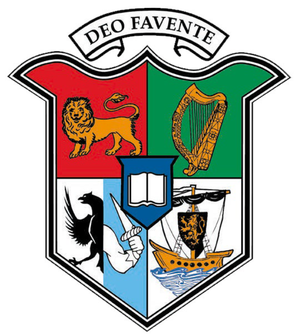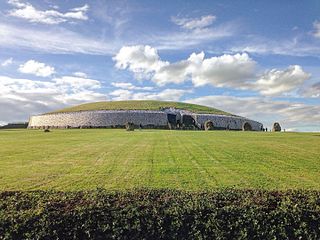Related Research Articles

The Bronze Age is a historic period, lasting from approximately 3300 BC to 1200 BC. Characterized by the use of bronze, the use of writing in some areas, and other features of early urban civilization, the Bronze Age is the second principal period of the three-age system proposed in 1836 by Christian Jürgensen Thomsen for classifying and studying ancient societies and history. It is also considered the second phase of three, in the Metal Ages.

A hillfort is a type of fortified refuge or defended settlement located to exploit a rise in elevation for defensive advantage. They are typically European and of the Bronze Age or Iron Age. Some were used in the post-Roman period. The fortification usually follows the contours of a hill and consists of one or more lines of earthworks or stone ramparts, with stockades or defensive walls, and external ditches. If enemies were approaching, the civilians would spot them from a distance.

The University of Galway is a public research university located in the city of Galway, Ireland.

D. P. Agrawal is a historian of Indian science and technology, archaeologist, and author. He has published works on Indian archaeology, metallurgy, the history of science, and palaeoclimate.

Prehistoric Wales in terms of human settlements covers the period from about 230,000 years ago, the date attributed to the earliest human remains found in what is now Wales, to the year AD 48 when the Roman army began a military campaign against one of the Welsh tribes. Traditionally, historians have believed that successive waves of immigrants brought different cultures into the area, largely replacing the previous inhabitants, with the last wave of immigrants being the Celts. However, studies of population genetics now suggest that this may not be true, and that immigration was on a smaller scale.

The prehistory of Ireland has been pieced together from archaeological evidence, which has grown at an increasing rate over the last decades. It begins with the first evidence of permanent human residence in Ireland around 10,500 BC and finishes with the start of the historical record around 400 AD. Both the beginning and end dates of the period are later than for much of Europe and all of the Near East. The prehistoric period covers the Palaeolithic, Mesolithic, Neolithic, Bronze Age and Iron Age societies of Ireland. For much of Europe, the historical record begins when the Romans invaded; as Ireland was not invaded by the Romans its historical record starts later, with the coming of Christianity.

The Uragh Stone Circle is an axial five-stone circle located near Gleninchaquin Park, County Kerry, Ireland. The Bronze Age site includes a multiple stone circle and some boulder burials.

Bronze Age Britain is an era of British history that spanned from c. 2500–2000 BC until c. 800 BC. Lasting for approximately 1,700 years, it was preceded by the era of Neolithic Britain and was in turn followed by the period of Iron Age Britain. Being categorised as the Bronze Age, it was marked by the use of copper and then bronze by the prehistoric Britons, who used such metals to fashion tools. Great Britain in the Bronze Age also saw the widespread adoption of agriculture.

Prehistory, also called pre-literary history, is the period of human history between the first known use of stone tools by hominins c. 3.3 million years ago and the beginning of recorded history with the invention of writing systems. The use of symbols, marks, and images appears very early among humans, but the earliest known writing systems appeared c. 5,200 years ago. It took thousands of years for writing systems to be widely adopted, with writing spreading to almost all cultures by the 19th century. The end of prehistory therefore came at different times in different places, and the term is less often used in discussing societies where prehistory ended relatively recently.

The Copper Age, also called the Eneolithic or the Chalcolithic Age, has been traditionally understood as a transitional period between the Neolithic and the Bronze Age, in which a gradual introduction of the metal took place, while stone was still the main resource utilized. Recent archaeology has found that the metal was not introduced so gradually and that this entailed significant social changes, such as developments in the type of habitation, long-distance trade, and copper metallurgy.
Mining archaeology is a specific field well-developed in the British Isles during recent decades. A reason of ongoing interest in this field is the particular bond between regional history and the exploitation of metals. References to mines in the area exist in Strabo's works. However the first accomplished study on the topic was attempted by Oliver Davies in 1935. Other momentous researches were that of geologist John S. Jackson about mines in Ireland and Lewis, Jones in Dolaucothi goldmine in Wales, and the pioneering work of Ronald F. Tylecote. Moreover, in the 1980s and 1990s a new generation of amateurs and scientists began investigations in different locations in the British Isles, including Duncan James on the Great Orme's Head, Simon Timberlake with the Early Mines Research Group at sites in Wales and William O'Brien in Ireland.
Barry Raftery was an Irish archaeologist and academic. He is best known for his pioneering work in wetland archaeology and Iron Age hillforts in Ireland. He was Professor of Celtic Archaeology in University College Dublin (UCD) for more than thirty years, and served as chair of the Department of Celtic Archeology at UCD from 1996 to his retirement in 2007.

Sue Hamilton is a British archaeologist and Professor of Prehistory at the UCL Institute of Archaeology. A material culture specialist and landscape archaeologist, she was the UCL Institute of Archaeology's first permanent female director (2014–22).

Hillforts in Scotland are earthworks, sometimes with wooden or stone enclosures, built on higher ground, which usually include a significant settlement, built within the modern boundaries of Scotland. They were first studied in the eighteenth century and the first serious field research was undertaken in the nineteenth century. In the twentieth century there were large numbers of archaeological investigations of specific sites, with an emphasis on establishing a chronology of the forts. Forts have been classified by type and their military and ritual functions have been debated.

Rathgall, or the Ring of the Rath is a large multivallate hill fort near the town of Shillelagh. Dating from the Bronze Age, it consists of three roughly concentric stone ramparts with a fourth masonry wall dating from the Medieval period at its centre. Rathgall is a National Monument which is in state care.
Cecily Margaret Guido,, also known as Peggy Piggott, was an English archaeologist, prehistorian, and finds specialist. Her career in British archaeology spanned sixty years, and she is recognised for her field methods, her field-leading research into prehistoric settlements, burial traditions, and artefact studies, as well as her high-quality and rapid publication, contributing more than 50 articles and books to her field between the 1930s and 1990s.
Joanna Bruck is an archaeologist and academic, who is a specialist on Bronze Age Britain and Ireland. Since 2020, she has been Professor of Archaeology and Head of the School of Archaeology at University College Dublin. She was previously Professor of Archaeology at the University of Bristol between 2013 and 2020.
Sara Champion was a British archaeologist with an interest in the European Iron Age and the role and visibility of women working in archaeology. She was editor of PAST, the newsletter of The Prehistoric Society from 1997 until her death in 2000. The Prehistoric Society hosts an annual Sara Champion Memorial Lecture.
Rachel PopeFSA is an archaeologist specialising in Iron Age Europe. She is Reader in European Prehistory at the University of Liverpool.

The Gleninsheen gorget is a late Bronze Age collar, found in 1930 in the Gleninsheen region of the Burren, County Clare, Ireland. Given that the gorget is made from gold and weighs 276 g (8.9 ozt) it must have been intended as an ornament for a high-ranking warrior. Dated to c. 800–700 BC, it is one of the earliest examples of substantial Irish goldwork, although the gorget may represent a development of the much earlier, and lighter, gold lunula form. Both are mainly found in Ireland.
References
- ↑ "University College Cork". UCC. Retrieved 4 August 2021.
- ↑ "William Francis O'Brien". Royal Irish Academy. 19 October 2015. Retrieved 4 August 2021.
- ↑ "University College Cork". UCC. Retrieved 12 May 2021.
- ↑ O’Mahony, David (13 October 2012). "Our landscapes tell the stories of island's past". Irish Examiner. Retrieved 6 September 2021.